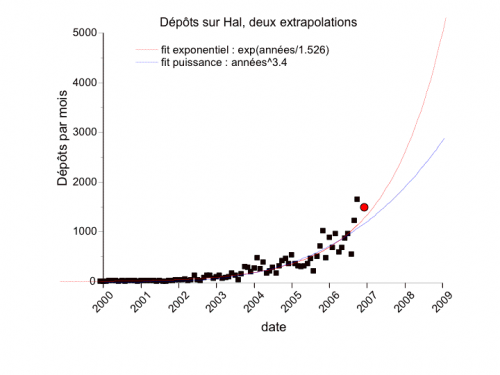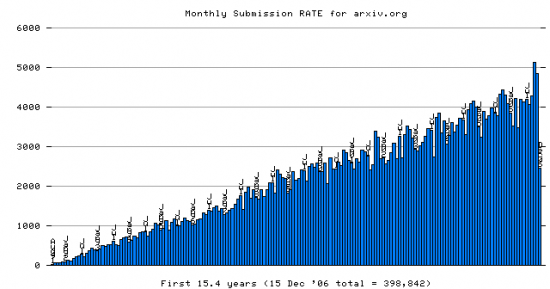Thursday, December 28. 2006
In " Quantum Game Theory and Open Access Publishing," Hanauske et al (2006) try to use game-theoretic modeling -- pitting "author-reputation" (in the form of citations) against "journal-reputation" -- to show that authors will inevitably switch from "traditional publishing" to "open access publishing." This would be a welcome conclusion if Hanauske et al's underlying assumptions and their definition of OA publishing had been valid. But the article defines "Green OA" as self-archiving in an Institutional Repository, "Gold OA" as publishing in an OA journal, and "OA Publishing" as a "third option," with self-archiving in Arxiv (a Central Repository) as its prime example. In reality, of course, self-archiving in Arxiv is not OA publishing at all, but simply another example of OA self-archiving ( Green OA). Hence the assumption that "OA Publishing" (in this incorrect sense) pits "author-reputation" (citations) game-theoretically against "journal-reputation" (with citations eventually winning) is invalid too. The correct conclusion, requiring no game-theoretic modeling at all, is that OA will inevitably win over non-OA eventually (especially once accelerated by Green OA self-archiving mandates), simply because more citations are better than fewer citations. Nothing to do with OA publishing (Gold OA) in particular, which also benefits from more citations, nor with traditional publishing, which likewise benefits from more citations. Harnad, S., Brody, T., Vallieres, F., Carr, L., Hitchcock, S., Gingras, Y., Oppenheim, C., Stamerjohanns, H. and Hilf, E. (2004) The Access/Impact Problem and the Green and Gold Roads to Open Access. Serials Review 30(4).
Harnad, S. (2005) Fast-Forward on the Green Road to Open Access: The Case Against Mixing Up Green and Gold. Ariadne 43. Stevan Harnad
American Scientist Open Access Forum
Monday, December 25. 2006
 Here are actual and projected growth rate statistics for France's national OA Repository, HAL, kindly supplied by HAL's architect and helmsman, Franck Laloe. France's annual research output is about 12,000 articles per month, so HAL's present spontaneous deposit rate of 1600 articles per month is about the same as the baseline of 15% for spontaneous (unmandated) self-archiving worldwide today. 
 Monthly Deposits in HAL: Two Extrapolations Monthly Deposits in HAL: Two Extrapolations
[Linearlog/log fit and projections done via Origin]
Spontaneous self-archiving in HAL seems to have begun in about 2002, so it is not clear whether the monthly deposit rate will continue to accelerate or was simply catching up with the baseline at which all other unmandated self-archiving rates have been idling for years now. If HAL's monthly deposit growth rate is indeed exponential, then HAL will reach 100% self-archiving in 5 years without a mandate; if it is a power curve ("puissance") it will take 15 years;  if (like Arxiv) it is linear, it will take even longer. (Arxiv's power exponent has been unchangingly quadratic for 15 years, HAL's so far seems ternary) Franck Laloe: [translated from French] "There are also some small research institutes in France which are already self-archiving 100% of their research output, for example IN2P3, a component (high-energy physics) of CNRS. A team of 3 documentalists deposits 100% of IN2P3 article output in Hal-IN2P3, because on a small scale this is possible. Another example is IFREMER, a small institute for research on seas and oceans. They have a small, well-done archive containing 100% of their output. As to my own field of research, it has been self-archiving at 99% in ArXiv for a long time…" There seem to be two morals to this story: (1) Even a centralised national archiving system in a centralised country like France, cannot succeed without a national deposit mandate; (2) until France adopts a national deposit mandate, it too, like all other countries, will have to rely on individual institutional (and research-funder) mandates.
Pertinent Prior AmSci Topic Threads:
Are things otherwise in France? (began May, 1999)
INIST/CNRS : nouveautés du site Libre Accès (Dec 2004)
France's INRIA Registers Commitment to Implement Berlin Declaration Self-Archiving Policy Recommendation (Mar 2005)
France's CNRS Registers Commitment to Implement Berlin Declaration Self-Archiving Policy Recommendation (May 2005)
Hélène Bosc et le progrès en accès libre en france (Mar 2006)
Guide juridique CNRS (Nov 2005)
CNRS position on OA : new details (Jun 2006)
Forthcoming OA Developments in France (Jun 2006)
France's HAL, OAI interoperability, and Central vs Institutional Repositories (Oct 2006) Stevan Harnad
American Scientist Open Access Forum
Saturday, December 16. 2006
On Fri, 15 Dec 2006, Heather Morrison wrote in the American Scientist Open Access Forum: HM:"arXiv is showing very healthy growth, around 20% annually. I've been tracking arXiv on a quarterly basis, starting Dec. 31, 2005: [here]."
Arxiv has been showing this same, steady, unswerving linear increase in the number of deposits per month (quadratic acceleration of the total content) since the year 1991, and Arxiv has been tracking its own growth, monthly, since then.

The year 2006 is hence not the one in which to fete this as "very healthy" growth -- unless we want to wait till doomsday to reach 100% OA.
At this rate, Ebs Hilf estimates that it would take till 2050 to reach 100% OA in Physics. And that is without mentioning that Arxiv-style central self-archiving has not yet caught on in any other field (except possibly economics) since 1991. In contrast, distributed self-archiving in, for example, computer science, has already long overtaken Arxiv-style central self-archiving. See Citeseer (a harvester of locally self-archived papers in computer science, already twice the size of Arxiv):
Logic alone should alert us that ever since Institutional IRs and Central CRs became completely equivalent and interoperable, and seamlessly harvestable and integrable, with the OAI protocol of 1999, the days of CRs were numbered.
It makes no sense for institutional researchers either to deposit only in a CR instead of their own IR, or to double-deposit (in their own IR plus CRs, such as PubMed Central). The direct deposits will be in the natural locus, the researcher's own IR. And then CRs will harvest, as Citeseer, OAister -- and, for that matter, Google and Google Scholar -- do.
OA self-archiving is meant to be done in the interests of the impact, visibility, and recording of each institution's research output. Institutional self-archiving tiles all of OA space (whereas CRs would have to criss-cross all disciplines, willy-nilly, redundantly, and arbitrarily).
Most important, institutions, being the primary research providers, have the most direct stake in maximising -- and the most direct means of monitoring -- the self-archiving of their own research output. Hence institutional self-archiving mandates -- reinforced by research funder self-archiving mandates -- will see to it that institutional research output is deposited in its natural, optimal locus: each institution's own IR (twinned and mirrored for redundancy and preservation). CRs (subject-based, multi-subject, national, or any other combination that might be judged useful) can then harvest from the distributed network of IRs. - "Central vs. Distributed Archives" (began Jun 1999)
- "PubMed and self-archiving" (began Aug 2003)
- "Central versus institutional self-archiving" (began Nov 2003)
- "Harold Varmus: 'Self-Archiving is Not Open Access'" (began June 2006)
- Optimizing OA - Self-Archiving Mandates: What? Where? When? Why? How?
- Plugging the Loopholes in the Proposed FRPAA, RCUK and EU Self-Archiving Mandates
- Generic Rationale and Model for University Open Access Self-Archiving Mandate: Immediate-Deposit/Optional Access (ID/OA)
Swan, A., Needham, P., Probets, S., Muir, A., Oppenheim, C., O'Brien, A., Hardy, R., Rowland, F. and Brown, S. (2005) Developing a model for e-prints and open access journal content in UK further and higher education. Learned Publishing 18(1) pp. 25-40.ABSTRACT: A study carried out for the UK Joint Information Systems Committee examined models for the provision of access to material in institutional and subject-based archives and in open access journals. Their relative merits were considered, addressing not only technical concerns but also how e-print provision (by authors) can be achieved ? an essential factor for an effective e-print delivery service (for users). A "harvesting" model is recommended, where the metadata of articles deposited in distributed archives are harvested, stored and enhanced by a national service. This model has major advantages over the alternatives of a national centralized service or a completely decentralized one. Options for the implementation of a service based on the harvesting model are presented. Stevan Harnad
American Scientist Open Access Forum
|





